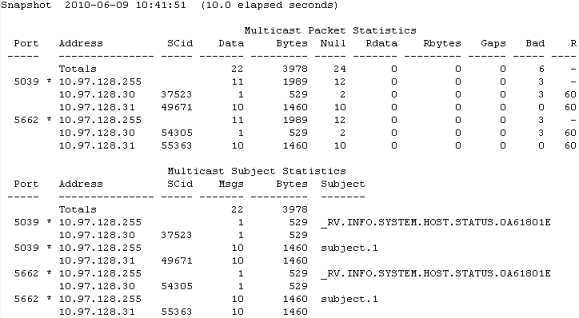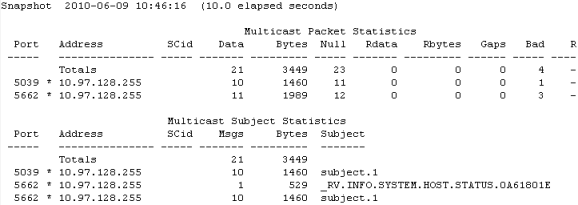Interpreting the Report
The remaining areas of this section describe the output from rvtrace.
rvtrace Output with -addrinfo shows a sample of the output that rvtrace prints at the conclusion of each interval, when the -addrinfo flag is present:
| • | Time stamp—identifies the interval |
| • | Multicast Data Statistics—summarizes Rendezvous multicast and broadcast packets during the interval, organized by UDP port (service) and destination address (see Multicast Data Statistics) |
| • | Multicast Retrans Statistics—summarizes requests to retransmit packets of multicast and broadcast data (this table does not appear in rvtrace Output with -addrinfo; see Multicast Retransmit Statistics) |
| • | PTP Statistics—summarizes Rendezvous point-to-point packets during the interval, organized by UDP port (service) and destination address (see Point-to-Point Statistics) |
| • | Subject Statistics—recapitulates Rendezvous multicast and broadcast message activity during the interval, featuring information about subject names (see Subject Statistics) |
Notice that each table begins with a network total, and then breaks down the total into subtotals and fine-grained categories.
rvtrace Output without -addrinfo shows a sample of the less verbose output that rvtrace prints when the -addrinfo flag is absent. Notice that tables omit the fine-grained categories—displaying only the network total and subtotals
General Network Load
To assess network load, inspect the Data and Bytes columns of the Multicast Data Statistics table, and the Data and Bytes columns of the Point-to-Point Statistics table.
Number of Senders
To determine the number of Rendezvous daemons that sent data messages during an interval, count the number of distinct source addresses in all source rows of the Multicast Data Statistics table and the Point-to-Point Statistics table.
Scanning for Problems
To quickly review rvtrace output for problems, scan down the right side of the page, looking for non-zero values in the Bad, Gaps, and Rbytes columns of the multicast data tables. Non-zero values in these columns indicate a problem; look more closely at statistics in other columns in that interval and subsequent intervals.
Figure 147: rvtrace Output with -addrinfo

Figure 148: rvtrace Output without -addrinfo

Bad Packets
Bad packets lack UDP checksums, or are corrupt in some other way.
|
Warning |
Bad packets usually indicate a severe misconfiguration or network problem. Remedy the situation immediately. |
|
Note |
Checksums are crucial to correct operation of Rendezvous software; see Enable Packet Checksums. |
In some situations, rvtrace can incorrectly report bad packets.
When a sending host computer enables checksum off-loading features, the network interface card (rather than the CPU) adds checksums to outbound packets. If rvtrace is running on the same host as the sender, it captures outbound packets before the checksums have been added. rvtrace detects the missing checksums, and reports bad packets. However, by the time these packets actually reach the network, they might not be bad packets.